Rustic Interior Design: The Ultimate Guide
This rugged, natural design is welcoming, cozy, and fairly easy to implement
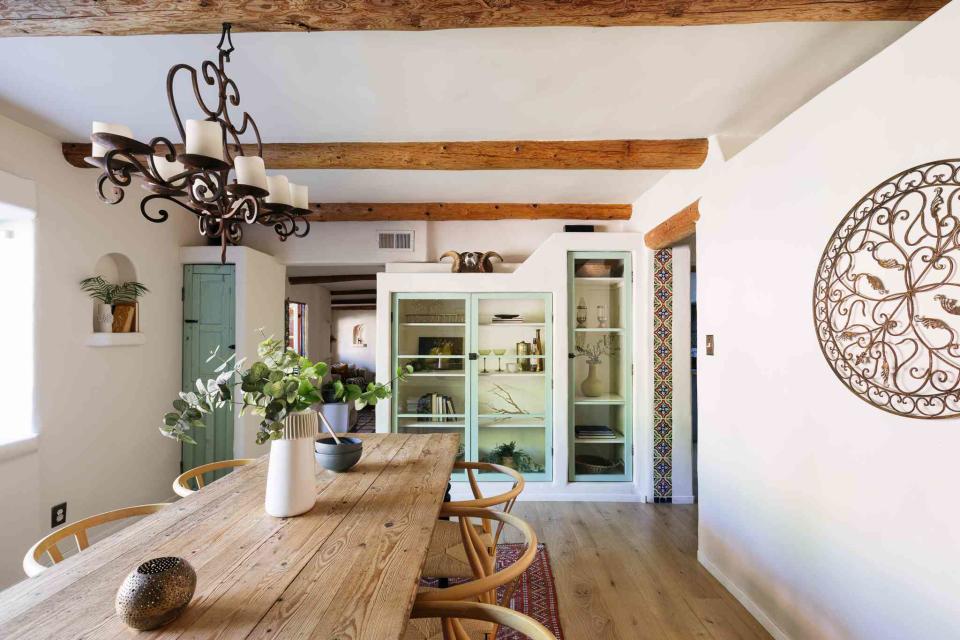
The Spruce / Christopher Lee Foto
Fact checked by Jillian DaraFact checked by Jillian Dara
Rustic interior design is warm, cozy, earthy, and welcoming. It can look like a lovely shabby chic farmhouse, a remote cabin in the woods, or anything in between. Achieve a rustic interior by emphasizing natural and organic elements such as reclaimed wood and an earthy color palette. Learn to spot this incredibly approachable and relaxed style and how to incorporate rustic decor into your home.
What Is Rustic Interior Design?
Rustic interior design is characterized by natural, aged, organic, and distressed elements. It is the opposite of modern or contemporary design. The style originated in the early 1800s when rugged homesteads were built in America's countryside using handcrafted raw and natural materials. It has evolved over the decades to include farmhouse design which can be more polished than traditional rustic design. Other design styles, like Tuscan and coastal, can also incorporate weathered rustic elements.
18 Cabin Decor Ideas for a Cozy, Homey Design
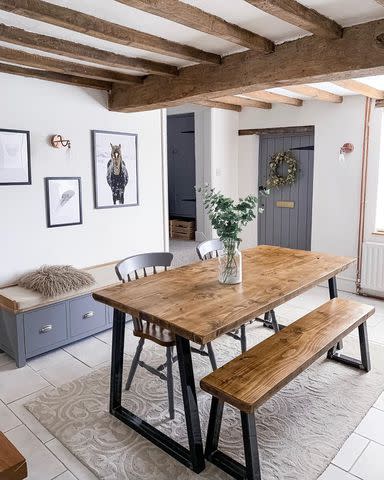
Key Characteristics of Rustic Design
Rustic decor is completely unpretentious or stuffy. Here are the key characteristics of rustic-style interior design:
Neutral colors: A monochromatic and muted color palette includes natural, neutral colors such as warmer tints of beiges, whites, browns, and grays without many splashes of bold color.
Natural materials: Rustic design focuses on materials from the earth, such as wood and stone, often used to build oversized stone fireplaces.
Reclaimed wood: Unfinished, exposed beams of reclaimed wood added to walls and ceilings exemplify rustic style.
Textures: Rugged textures include jute, burlap, and canvas used in rugs and accent pieces.
Fabrics: Natural linen, organic cotton, and wool in neutral colors that aren't overly dyed or embellished, are preferred in rustic interiors.
Handcrafted decor: Handmade wood or metal furnishings, pottery, woven baskets, wreaths, and homemade rugs bring character to a rustic-style home.
Types of Rustic Design
Elements of rustic design can be found in traditional and classic to modern and chic style interiors. Here's what to expect with varying styles:
Modern rustic style: The style blends traditional rustic elements with modern materials, such as reclaimed wood with glass or wrought iron, and more colorful artwork and decor.
Farmhouse rustic style: Interiors will have hints of rustic materials designed with a streamlined farmhouse, or industrialized look, also called industrial farmhouse style.
Cottage rustic style: The cottage style incorporates distressed and reclaimed rustic decor into bright, airy rooms with walls and textiles in lighter colors.
Western rustic style: This is the traditional look of American rustic style, and can incorporate aspects of Western and Southwestern design, such as rodeo images and animal hide rugs.
Scandi rustic style: Interiors have a minimalistic Scandinavian design aesthetic in a lighter color palette mixed with rustic elements like distressed wood furnishings and handcrafted items.
Industrial rustic style: Inspired by the trend of old industrial spaces converted into living areas, this style combines utilitarian and rustic features to create a warm, inviting, yet sleek and streamlined home.
How to Decorate With Rustic Style
Incorporate Reclaimed Wood
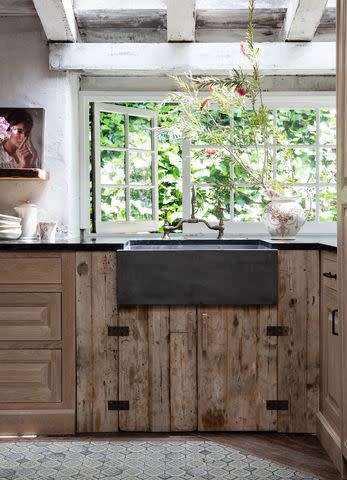
Design by Leanne Ford Interiors / Photo by Amy Neunsinger
Craft a rustic interior with authentic wooden wide-planked floors and reclaimed wood farmhouse tables, furnishings, and cabinetry. Weathered wood is ideal for rugged rustic interiors.
Add Contrasting Textures
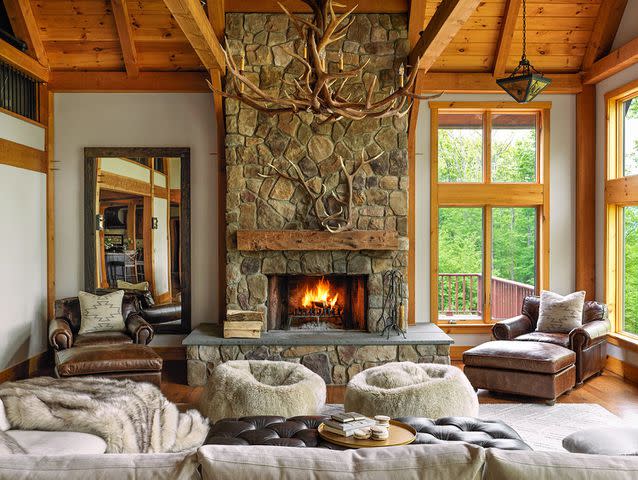
Design by AHG Interiors / Photo by Chris Mottalini
Bring texture into a rustic interior with heavily-grained woods and huge, imperfect stone fireplaces. Avoid stones with shine or sheen to bring out the rough-hewn feel of a rustic space.
Opt for Handmade Items
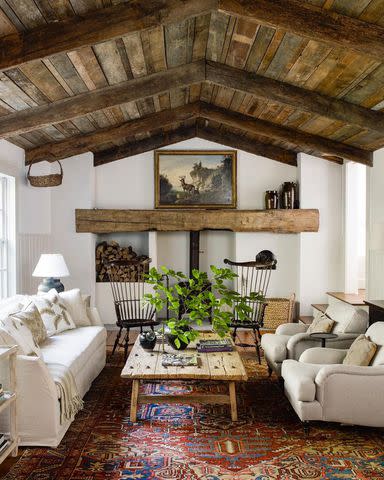
Design by Lauren Liess Interiors / Photo by Helen Norman
Decorate with handcrafted items, such as this rustic mantel and handmade coffee table. The beamed ceiling is made from well-worn reclaimed wood. Imperfections in the material and the crafting techniques feel welcome, signaling it's time to put your feet up and relax.
Focus on Heavy Materials
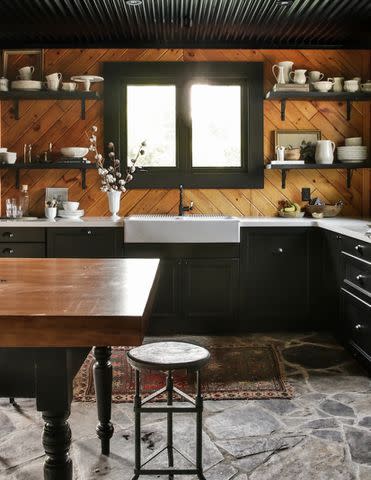
Welcome the rustic nature of beefy wood kitchen tables, chunky natural stone floors, or oversized couches with deep, dark leather upholstery. Unlike other trendy decor styles like midcentury modern rustic design features heavy materials and darker earthy colors that bring a sense of stability and permanence to a home.
Keep Furniture Simple
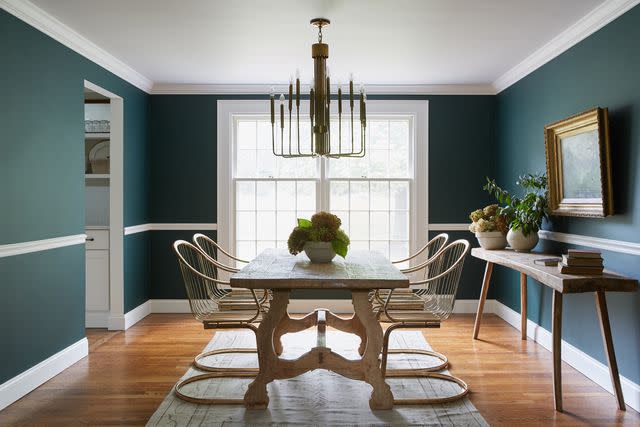
Design by Leanne Ford Interiors / Photo by Reid Rolls
Choose simple furnishings for rustic interiors. Streamlined tables and chairs allow the eye to focus on the beauty of the material they are constructed from rather than their shapes.
Embrace Exposed Beams
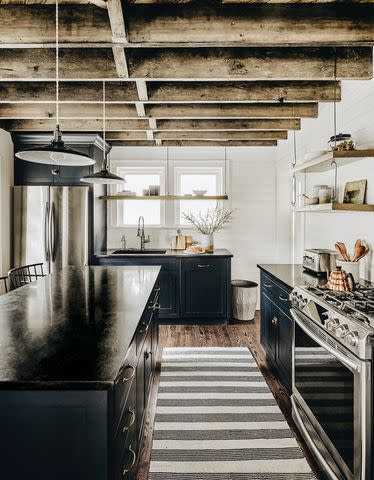
Keep exposed ceiling beams unfinished. Whether it's a rustic farmhouse in the country or a coastal Tuscan home, exposed beams symbolize rustic design.
Frequently Asked Questions
What are the best colors to use for rustic design?
Use warmer neutrals for rustic interiors. Neutrals work well with earthy wood furnishings, beams, metal decor, and stone surfaces.
How can I make my house look more rustic?
Make your house look more rustic with a neutral earthy color palette, reclaimed wood floors and stone surfaces, and handcrafted furnishings and decor.
What type of furniture is used in rustic design?
Handcrafted, distressed wood furnishings with traditional silhouettes, such as farmhouse tables and Windsor back chairs, work best in rustic design.
Read the original article on The Spruce.
